Electromagnetic
Waves and Antennas
�
Electromagnetic
Waves and Antennas
Sophocles J. Orfanidis
Rutgers University
To Monica and John
�
Contents
Preface xiv
1 Maxwell’s Equations 1
Lorentz Force, 2
Constitutive Relations, 3
Boundary Conditions, 6
Currents, Fluxes, and Conservation Laws, 8
Charge Conservation, 9
Energy Flux and Energy Conservation, 10
1.1 Maxwell’s Equations, 1
1.2
1.3
1.4
1.5
1.6
1.7
1.8 Harmonic Time Dependence, 12
1.9
1.10 Problems, 21
Simple Models of Dielectrics, Conductors, and Plasmas, 13
2 Uniform Plane Waves 25
Energy Density and Flux, 34
Uniform Plane Waves in Lossless Media, 25
2.1
2.2 Monochromatic Waves, 31
2.3
2.4 Wave Impedance, 35
Polarization, 35
2.5
Uniform Plane Waves in Lossy Media, 42
2.6
Propagation in Weakly Lossy Dielectrics, 48
2.7
Propagation in Good Conductors, 49
2.8
2.9
Propagation in Oblique Directions, 50
2.10 Complex or Inhomogeneous Waves, 53
2.11 Doppler Effect, 55
2.12 Problems, 59
3
Propagation in Birefringent Media 65
Linear and Circular Birefringence, 65
Uniaxial and Biaxial Media, 66
Chiral Media, 68
Gyrotropic Media, 71
Linear and Circular Dichroism, 72
3.1
3.2
3.3
3.4
3.5
3.6 Oblique Propagation in Birefringent Media, 73
3.7
Problems, 80
vii
viii
Electromagnetic Waves & Antennas – S. J. Orfanidis – June 21, 2004
4 Reflection and Transmission 86
Propagation Matrices, 86
4.1
4.2 Matching Matrices, 90
4.3
4.4
4.5
4.6
4.7
4.8
4.9
Reflected and Transmitted Power, 93
Single Dielectric Slab, 96
Reflectionless Slab, 99
Time-Domain Reflection Response, 107
Two Dielectric Slabs, 109
Reflection by a Moving Boundary, 111
Problems, 114
5 Multilayer Structures 117
5.1 Multiple Dielectric Slabs, 117
5.2
Antireflection Coatings, 119
5.3 Dielectric Mirrors, 124
5.4
5.5
5.6
5.7
5.8
5.9
Propagation Bandgaps, 135
Narrow-Band Transmission Filters, 135
Equal Travel-Time Multilayer Structures, 140
Applications of Layered Structures, 154
Chebyshev Design of Reflectionless Multilayers, 157
Problems, 165
6 Oblique Incidence 168
Transverse Impedance, 170
Propagation and Matching of Transverse Fields, 173
Fresnel Reflection Coefficients, 175
Total Internal Reflection, 177
Brewster Angle, 183
Complex Waves, 186
6.1 Oblique Incidence and Snell’s Laws, 168
6.2
6.3
6.4
6.5
6.6
6.7
6.8 Oblique Reflection by a Moving Boundary, 196
6.9
Geometrical Optics, 199
6.10 Fermat’s Principle, 202
6.11 Ray Tracing, 204
6.12 Problems, 215
7 Multilayer Film Applications 217
Lossy Multilayer Structures, 219
Single Dielectric Slab, 221
Antireflection Coatings at Oblique Incidence, 223
7.1 Multilayer Dielectric Structures at Oblique Incidence, 217
7.2
7.3
7.4
7.5 Omnidirectional Dielectric Mirrors, 227
7.6
7.7
7.8
7.9 Multilayer Birefringent Structures, 247
7.10 Giant Birefringent Optics, 249
Polarizing Beam Splitters, 237
Reflection and Refraction in Birefringent Media, 240
Brewster and Critical Angles in Birefringent Media, 244
�
www.ece.rutgers.edu/∼orfanidi/ewa
7.11 Problems, 254
8 Waveguides 255
Longitudinal-Transverse Decompositions, 256
8.1
Power Transfer and Attenuation, 261
8.2
TEM, TE, and TM modes, 263
8.3
8.4
Rectangular Waveguides, 266
8.5 Higher TE and TM modes, 268
8.6 Operating Bandwidth, 270
8.7
8.8
8.9
8.10 Resonant Cavities, 278
8.11 Dielectric Slab Waveguides, 280
8.12 Problems, 288
Power Transfer, Energy Density, and Group Velocity, 271
Power Attenuation, 273
Reflection Model of Waveguide Propagation, 276
9 Transmission Lines 290
Coaxial Lines, 301
Two-Wire Lines, 306
Two-Port Equivalent Circuit, 312
Terminated Transmission Lines, 313
General Properties of TEM Transmission Lines, 290
Parallel Plate Lines, 296
9.1
9.2
9.3 Microstrip Lines, 297
9.4
9.5
9.6 Distributed Circuit Model of a Transmission Line, 308
9.7 Wave Impedance and Reflection Response, 310
9.8
9.9
9.10 Power Transfer from Generator to Load, 316
9.11 Open- and Short-Circuited Transmission Lines, 318
9.12 Standing Wave Ratio, 321
9.13 Determining an Unknown Load Impedance, 323
9.14 Smith Chart, 327
9.15 Time-Domain Response of Transmission Lines, 331
9.16 Problems, 338
10 Coupled Lines 347
10.1 Coupled Transmission Lines, 347
10.2 Crosstalk Between Lines, 353
10.3 Weakly Coupled Lines with Arbitrary Terminations, 356
10.4 Coupled-Mode Theory, 358
10.5 Fiber Bragg Gratings, 360
10.6 Diffuse Reflection and Transmission, 363
10.7 Problems, 365
11 Impedance Matching 366
11.1 Conjugate and Reflectionless Matching, 366
11.2 Multisection Transmission Lines, 368
11.3 Quarter-Wavelength Chebyshev Transformers, 369
ix
x
Electromagnetic Waves & Antennas – S. J. Orfanidis – June 21, 2004
11.4 Two-Section Dual-Band Chebyshev Transformers, 375
11.5 Quarter-Wavelength Transformer With Series Section, 381
11.6 Quarter-Wavelength Transformer With Shunt Stub, 384
11.7 Two-Section Series Impedance Transformer, 386
11.8 Single Stub Matching, 391
11.9 Balanced Stubs, 395
11.10 Double and Triple Stub Matching, 397
11.11 L-Section Lumped Reactive Matching Networks, 399
11.12 Pi-Section Lumped Reactive Matching Networks, 402
11.13 Reversed Matching Networks, 409
11.14 Problems, 411
12 S-Parameters 413
12.1 Scattering Parameters, 413
12.2 Power Flow, 417
12.3 Parameter Conversions, 418
12.4 Input and Output Reflection Coefficients, 419
12.5 Stability Circles, 421
12.6 Power Gains, 427
12.7 Generalized S-Parameters and Power Waves, 433
12.8 Simultaneous Conjugate Matching, 437
12.9 Power Gain Circles, 442
12.10 Unilateral Gain Circles, 443
12.11 Operating and Available Power Gain Circles, 445
12.12 Noise Figure Circles, 451
12.13 Problems, 456
13 Radiation Fields 458
13.1 Currents and Charges as Sources of Fields, 458
13.2 Retarded Potentials, 460
13.3 Harmonic Time Dependence, 463
13.4 Fields of a Linear Wire Antenna, 465
13.5 Fields of Electric and Magnetic Dipoles, 467
13.6 Ewald-Oseen Extinction Theorem, 472
13.7 Radiation Fields, 477
13.8 Radial Coordinates, 480
13.9 Radiation Field Approximation, 482
13.10 Computing the Radiation Fields, 483
13.11 Problems, 485
14 Transmitting and Receiving Antennas 488
14.1 Energy Flux and Radiation Intensity, 488
14.2 Directivity, Gain, and Beamwidth, 489
14.3 Effective Area, 494
14.4 Antenna Equivalent Circuits, 498
14.5 Effective Length, 500
14.6 Communicating Antennas, 502
14.7 Antenna Noise Temperature, 504
�
www.ece.rutgers.edu/∼orfanidi/ewa
14.8 System Noise Temperature, 508
14.9 Data Rate Limits, 514
14.10 Satellite Links, 516
14.11 Radar Equation, 519
14.12 Problems, 521
15 Linear and Loop Antennas 522
15.1 Linear Antennas, 522
15.2 Hertzian Dipole, 524
15.3 Standing-Wave Antennas, 526
15.4 Half-Wave Dipole, 528
15.5 Monopole Antennas, 530
15.6 Traveling-Wave Antennas, 531
15.7 Vee and Rhombic Antennas, 534
15.8 Loop Antennas, 537
15.9 Circular Loops, 539
15.10 Square Loops, 540
15.11 Dipole and Quadrupole Radiation, 541
15.12 Problems, 543
16 Radiation from Apertures 544
16.1 Field Equivalence Principle, 544
16.2 Magnetic Currents and Duality, 546
16.3 Radiation Fields from Magnetic Currents, 548
16.4 Radiation Fields from Apertures, 549
16.5 Huygens Source, 552
16.6 Directivity and Effective Area of Apertures, 554
16.7 Uniform Apertures, 556
16.8 Rectangular Apertures, 556
16.9 Circular Apertures, 558
16.10 Vector Diffraction Theory, 561
16.11 Extinction Theorem, 565
16.12 Vector Diffraction for Apertures, 567
16.13 Fresnel Diffraction, 568
16.14 Knife-Edge Diffraction, 572
16.15 Geometrical Theory of Diffraction, 578
16.16 Problems, 584
17 Aperture Antennas 587
17.1 Open-Ended Waveguides, 587
17.2 Horn Antennas, 591
17.3 Horn Radiation Fields, 593
17.4 Horn Directivity, 598
17.5 Horn Design, 601
17.6 Microstrip Antennas, 604
17.7 Parabolic Reflector Antennas, 610
17.8 Gain and Beamwidth of Reflector Antennas, 612
17.9 Aperture-Field and Current-Distribution Methods, 615
xi
xii
Electromagnetic Waves & Antennas – S. J. Orfanidis – June 21, 2004
17.10 Radiation Patterns of Reflector Antennas, 618
17.11 Dual-Reflector Antennas, 627
17.12 Lens Antennas, 630
17.13 Problems, 631
18 Antenna Arrays 632
18.1 Antenna Arrays, 632
18.2 Translational Phase Shift, 632
18.3 Array Pattern Multiplication, 634
18.4 One-Dimensional Arrays, 644
18.5 Visible Region, 646
18.6 Grating Lobes, 647
18.7 Uniform Arrays, 650
18.8 Array Directivity, 654
18.9 Array Steering, 655
18.10 Array Beamwidth, 657
18.11 Problems, 659
19 Array Design Methods 661
19.1 Array Design Methods, 661
19.2 Schelkunoff’s Zero Placement Method, 664
19.3 Fourier Series Method with Windowing, 666
19.4 Sector Beam Array Design, 667
19.5 Woodward-Lawson Frequency-Sampling Design, 672
19.6 Narrow-Beam Low-Sidelobe Designs, 676
19.7 Binomial Arrays, 680
19.8 Dolph-Chebyshev Arrays, 682
19.9 Taylor-Kaiser Arrays, 694
19.10 Multibeam Arrays, 697
19.11 Problems, 700
20 Currents on Linear Antennas 701
20.1 Hall´en and Pocklington Integral Equations, 701
20.2 Delta-Gap and Plane-Wave Sources, 704
20.3 Solving Hall´en’s Equation, 705
20.4 Sinusoidal Current Approximation, 707
20.5 Reflecting and Center-Loaded Receiving Antennas, 708
20.6 King’s Three-Term Approximation, 711
20.7 Numerical Solution of Hall´en’s Equation, 715
20.8 Numerical Solution Using Pulse Functions, 718
20.9 Numerical Solution for Arbitrary Incident Field, 722
20.10 Numerical Solution of Pocklington’s Equation, 724
20.11 Problems, 730
�
www.ece.rutgers.edu/∼orfanidi/ewa
21 Coupled Antennas 731
21.1 Near Fields of Linear Antennas, 731
21.2 Self and Mutual Impedance, 734
21.3 Coupled Two-Element Arrays, 738
21.4 Arrays of Parallel Dipoles, 741
21.5 Yagi-Uda Antennas, 750
21.6 Hall´en Equations for Coupled Antennas, 755
21.7 Problems, 762
22 Appendices 764
A
B
C
D
E
F
G
H
Physical Constants, 764
Electromagnetic Frequency Bands, 765
Vector Identities and Integral Theorems, 767
Green’s Functions, 770
Coordinate Systems, 773
Fresnel Integrals, 775
Lorentz Transformations, 778
MATLAB Functions, 785
References 790
Index 820
xiii
Preface
This text provides a broad and applications-oriented introduction to electromagnetic
waves and antennas. Current interest in these areas is driven by the growth in wireless
and fiber-optic communications, information technology, and materials science.
Communications, antenna, radar, and microwave engineers must deal with the gener-
ation, transmission, and reception of electromagnetic waves. Device engineers working
on ever-smaller integrated circuits and at ever higher frequencies must take into account
wave propagation effects at the chip and circuit-board levels. Communication and com-
puter network engineers routinely use waveguiding systems, such as transmission lines
and optical fibers. Novel recent developments in materials, such as photonic bandgap
structures, omnidirectional dielectric mirrors, and birefringent multilayer films, promise
a revolution in the control and manipulation of light. These are just some examples of
topics discussed in this book. The text is organized around three main topic areas:
and design of multilayer films.
• The propagation, reflection, and transmission of plane waves, and the analysis
• Waveguides, transmission lines, impedance matching, and S-parameters.
• Linear and aperture antennas, scalar and vector diffraction theory, antenna array
design, and coupled antennas.
The text emphasizes connections to other subjects. For example, the mathematical
techniques for analyzing wave propagation in multilayer structures and the design of
multilayer optical filters are the same as those used in digital signal processing, such
as the lattice structures of linear prediction, the analysis and synthesis of speech, and
geophysical signal processing. Similarly, antenna array design is related to the prob-
lem of spectral analysis of sinusoids and to digital filter design, and Butler beams are
equivalent to the FFT.
Use
The book is appropriate for first-year graduate or senior undergraduate students. There
is enough material in the book for a two-semester course sequence. The book can also
be used by practicing engineers and scientists who want a quick review that covers most
of the basic concepts and includes many application examples.
The book is based on lecture notes for a first-year graduate course on “Electromag-
netic Waves and Radiation” that I have been teaching at Rutgers over the past twenty
xiv
�
www.ece.rutgers.edu/∼orfanidi/ewa
xv
xvi
Electromagnetic Waves & Antennas – S. J. Orfanidis – June 21, 2004
years. The course draws students from a variety of fields, such as solid-state devices,
wireless communications, fiber optics, abiomedical engineering, and digital signal and
array processing. Undergraduate seniors have also attended the graduate course suc-
cessfully.
The book requires a prerequisite course on electromagnetics, typically offered at the
junior year. Such introductory course is usually followed by a senior-level elective course
on electromagnetic waves, which covers propagation, reflection, and transmission of
waves, waveguides, transmission lines, and perhaps some antennas. This book may be
used in such elective courses with the appropriate selection of chapters.
At the graduate level, there is usually an introductory course that covers waves,
guides, lines, and antennas, and this is followed by more specialized courses on an-
tenna design, microwave systems and devices, optical fibers, and numerical techniques
in electromagnetics. No single book can possibly cover all of the advanced courses.
This book may be used as a text in the initial course, and as a supplementary text in the
specialized courses.
Contents and Highlights
In the first four chapters, we review Maxwell’s equations, boundary conditions, charge
and energy conservation, and simple models of dielectrics, conductors, and plasmas,
and discuss uniform plane wave propagation in various types of media, such as lossless,
lossy, isotropic, birefringent, and chiral media. We introduce the methods of transfer
and matching matrices for analyzing propagation, reflection, and transmission prob-
lems. Such methods are used extensively later on.
In chapter five on multilayer structures, we develop a transfer matrix approach to
the reflection and transmission through a multilayer dielectric stack and apply it to
antireflection coatings. We discuss dielectric mirrors constructed from periodic multi-
layers, introduce the concepts of Bloch wavenumber and reflection bands, and develop
analytical and numerical methods for the computation of reflection bandwidths and of
the frequency response. We discuss the connection to the new field of photonic and
other bandgap structures. We consider the application of quarter-wave phase-shifted
Fabry-Perot resonator structures in the design of narrow-band transmission filters for
dense wavelength-division multiplexing applications.
We discuss equal travel-time multilayer structures, develop the forward and back-
ward lattice recursions for computing the reflection and transmission responses, and
make the connection to similar lattice structures in other fields, such as in linear pre-
diction and speech processing. We apply the equal travel-time analysis to the design
of quarter-wavelength Chebyshev reflectionless multilayers. Such designs are also used
later in multi-section quarter-wavelength transmission line transformers. The designs
are exact and not based on the small-reflection-coefficient approximation that is usually
made in the literature.
In chapters six and seven, we discuss oblique incidence concepts and applications,
such as Snell’s laws, TE and TM polarizations, transverse impedances, transverse trans-
fer matrices, Fresnel reflection coefficients, total internal reflection and Brewster angles.
There is a brief introduction of how geometrical optics arises from wave propagation
in the high-frequency limit. Fermat’s principle is applied to derive the ray equations in
inhomogeneous media. We present several exactly solvable ray-tracing examples drawn
from applications such as atmospheric refraction, mirages, ionospheric refraction, prop-
agation in a standard atmosphere, the effect of Earth’s curvature, and propagation in
graded-index optical fibers.
We apply the transfer matrix approach to the analysis and design of omnidirectional
dielectric mirrors and polarizing beam splitters. We discuss reflection and refraction in
birefringent media, birefringent multilayer films, and giant birefringent optics.
Chapters 8–10 deal with waveguiding systems. We begin with the decomposition of
Maxwell’s equations into longitudinal and transverse components and focus primarily
on rectangular waveguides, resonant cavities, and dielectric slab guides. We discuss
issues regarding the operating bandwidth, group velocity, power transfer, and ohmic
losses. Then, we go on to discuss various types of TEM transmission lines, such as
parallel plate and microstrip, coaxial, and parallel-wire lines.
We consider general properties of lines, such as wave impedance and reflection re-
sponse, how to analyze terminated lines and compute power transfer from generator
to load, matched-line and reflection losses, Th´evenin and Norton equivalent circuits,
standing wave ratios, determining unknown load impedances, the Smith chart, and the
transient behavior of lines.
We discuss coupled lines, develop the even-odd mode decomposition for identical
matched or unmatched lines, and derive the crosstalk coefficients. The problem of
crosstalk on weakly-coupled non-identical lines with arbitrary terminations is solved in
general. We present also a short introduction to coupled-mode theory, co-directional
couplers, fiber Bragg gratings as examples of contra-directional couplers, and quarter-
wave phase-shifted fiber Bragg gratings as narrow-band transmission filters. We also
present briefly the Schuster-Kubelka-Munk theory of diffuse reflection and transmission
as an example of contra-directional coupling.
Chapters 11 and 12 discuss impedance matching and S-parameter techniques. Sev-
eral matching methods are included, such as wideband multi-section quarter-wavelength
impedance transformers, two-section dual-band transformers, quarter-wavelength trans-
formers with series sections or with shunt stubs, two-section transformers, single-stub
tuners, balanced stubs, double- and triple-stub tuners, L-, T-, and Π-section lumped
reactive matching networks and their Q-factors.
We have included an introduction to S-parameters because of their widespread use
in microwave measurements and in the design of microwave circuits. We discuss power
flow, parameter conversions, input and output reflection coefficients, stability circles,
power gain definitions (transducer, operating, and available gains), power waves and gen-
eralized S-parameters, simultaneous conjugate matching, power gain and noise-figure
circles on the Smith chart and their uses in designing low-noise high-gain microwave
amplifiers.
The rest of the book deals with radiation and antennas. In chapters 13 and 14, we
consider the generation of radiation fields from charge and current distributions. We
introduce the Lorenz-gauge scalar and vector potentials and solve the resulting inhomo-
geneous Helmholtz equations. We illustrate the vector potential formalism with three
applications: (a) the fields generated by a linear wire antenna, (b) the near and far fields
of electric and magnetic dipoles, and (c) the Ewald-Oseen extinction theorem of molec-
�
www.ece.rutgers.edu/∼orfanidi/ewa
xvii
xviii
Electromagnetic Waves & Antennas – S. J. Orfanidis – June 21, 2004
ular optics. Then, we derive the far-field approximation for the radiation fields and
introduce the radiation vector.
We discuss general characteristics of transmitting and receiving antennas, such as
energy flux and radiation intensity, directivity, gain, beamwidth, effective area, gain-
beamwidth product, antenna equivalent circuits, effective length, polarization and load
mismatches, communicating antennas and Friis formula, antenna noise temperature,
system noise temperature, limits on bit rates, power budgets of satellite links, and the
radar equation.
Chapter 15 is an introduction to linear and loop antennas. Starting with the Hertzian
dipole, we present standing-wave antennas, the half-wave dipole, monopole antennas,
traveling wave antennas, vee and rhombic antennas, circular and square loops, and
dipole and quadruple radiation in general.
Chapters 16 and 17 deal with radiation from apertures. We start with the field
equivalence principle and the equivalent surface electric and magnetic currents given
in terms of the aperture fields, and extend the far-field approximation to include mag-
netic current sources, leading eventually to Kottler’s formulas for the fields radiated
from apertures. Duality transformations simplify the discussions. The special cases of
uniform rectangular and circular apertures are discussed in detail.
Then, we embark on a long justification of the field equivalent principle and the
derivation of the Stratton-Chu and Kottler-Franz formulas, and discuss vector diffrac-
tion theory. This material is rather difficult but we have broken down the derivations
into logical steps using several vector analysis identities from the appendix. Once the
ramifications of the Kottler formulas are discussed, we approximate the formulas with
the conventional Kirchhoff diffraction integrals and discuss the scalar theory of diffrac-
tion. We consider Fresnel diffraction through apertures and knife-edge diffraction and
present an introduction to the geometrical theory of diffraction through Sommerfeld’s
exact solution of diffraction by a conducting half-plane.
We apply the aperture radiation formulas to various types of aperture antennas,
such as open-ended waveguides, horns, microstrip antennas, and parabolic reflectors.
We present a computational approach for the calculation of horn radiation patterns and
optimum horn design. We consider parabolic reflectors in some detail, discussing the
aperture-field and current-distribution methods, reflector feeds, gain and beamwidth
properties, and numerical computations of the radiation patterns. We also discuss
briefly dual-reflector and lens antennas.
Chapters 18 and 19 discuss antenna arrays. We start with the concept of the array
factor, which determines the angular pattern of the array. We emphasize the connection
to DSP and view the array factor as the spatial equivalent of the transfer function of an
FIR digital filter. We introduce basic array concepts, such as the visible region, grating
lobes, directivity, beamwidth, array scanning and steering, and discuss the properties
of uniform arrays. We present several array design methods for achieving a desired
angular radiation pattern, such as Schelkunoff’s zero-placement method, the Fourier
series method with windowing, and its variant, the Woodward-Lawson method, known
in DSP as the frequency-sampling method.
The issues of properly choosing a window function to achieve desired passband and
stopband characteristics are discussed. We emphasize the use of the Taylor-Kaiser win-
dow, which allows the control of the stopband attenuation. Using Kaiser’s empirical for-
mulas, we develop a systematic method for designing sector-beam patterns—a problem
equivalent to designing a bandpass FIR filter. We apply the Woodward-Lawson method
to the design of shaped-beam patterns. We view the problem of designing narrow-
beam low-sidelobe arrays as equivalent to the problem of spectral analysis of sinusoids.
Choosing different window functions, we arrive at binomial, Dolph-Chebyshev, and Tay-
lor arrays. We also discuss multi-beam arrays, Butler matrices and beams, and their
connection to the FFT.
In chapters 20 and 21, we undertake a more precise study of the currents flowing
on a linear antenna and develop the Hall´en and Pocklington integral equations for this
problem. The nature of the sinusoidal current approximation and its generalizations
by King are discussed, and compared with the exact numerical solutions of the integral
equations. We discuss coupled antennas, define the mutual impedance matrix, and use
it to obtain simple solutions for several examples, such as Yagi-Uda and other parasitic
or driven arrays. We also consider the problem of solving the coupled integral equations
for an array of parallel dipoles, implement it with MATLAB, and compare the exact results
with those based on the impedance matrix approach.
Our MATLAB-based numerical solutions are not meant to replace sophisticated com-
mercial field solvers. The inclusion of numerical methods in this book was motivated
by the desire to provide the reader with some simple tools for self-study and experi-
mentation. The study of numerical methods in electromagnetics is a subject in itself
and our treatment does not do justice to it. However, we felt that it would be fun to be
able to quickly compute fairly accurate radiation patterns of Yagi-Uda and other coupled
antennas, as well as radiation patterns of horn and reflector antennas.
The appendix includes summaries of physical constants, electromagnetic frequency
bands, vector identities, integral theorems, Green’s functions, coordinate systems, Fres-
nel integrals, and a detailed list of the MATLAB functions. Finally, there is a large (but
inevitably incomplete) list of references, arranged by topic area, that we hope could
serve as a starting point for further study.
MATLAB Toolbox
The text makes extensive use of MATLAB. We have developed an “Electromagnetic Waves
& Antennas” toolbox containing 130 MATLAB functions for carrying out all of the com-
putations and simulation examples in the text. Code segments illustrating the usage
of these functions are found throughout the book, and serve as a user manual. The
functions may be grouped into the following categories:
1. Design and analysis of multilayer film structures, including antireflection coat-
ings, polarizers, omnidirectional mirrors, narrow-band transmission filters, bire-
fringent multilayer films and giant birefringent optics.
2. Design of quarter-wavelength impedance transformers and other impedance match-
ing methods, such as Chebyshev transformers, dual-band transformers, stub match-
ing and L-, Π- and T-section reactive matching networks.
3. Design and analysis of transmission lines and waveguides, such as microstrip lines
and dielectric slab guides.
�

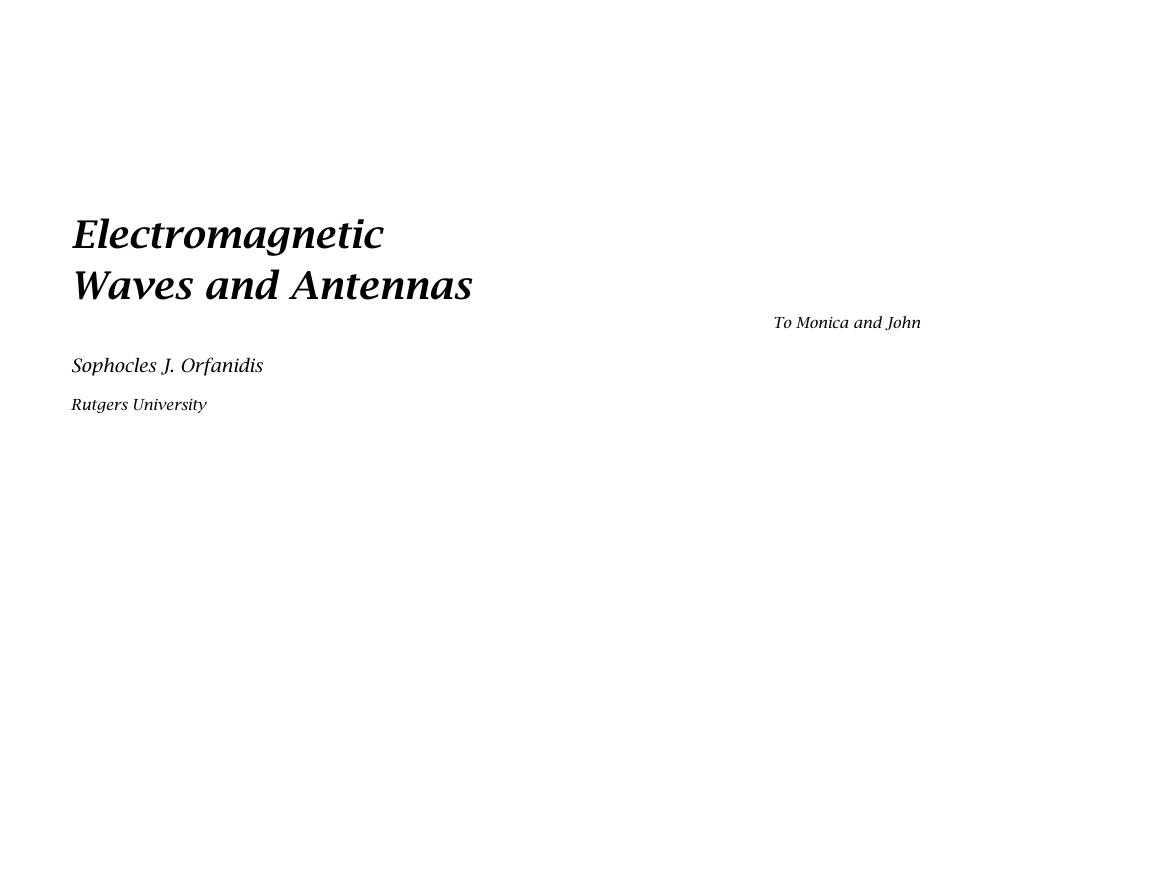
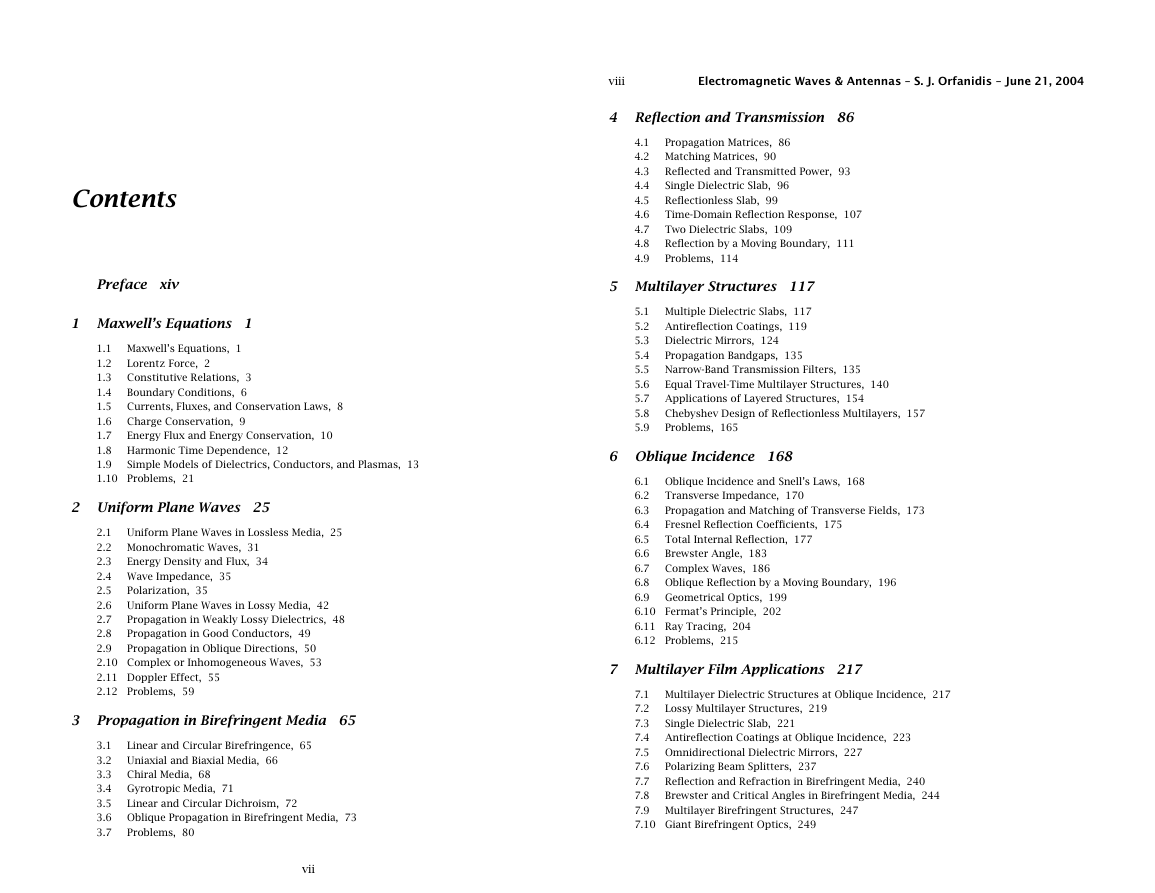
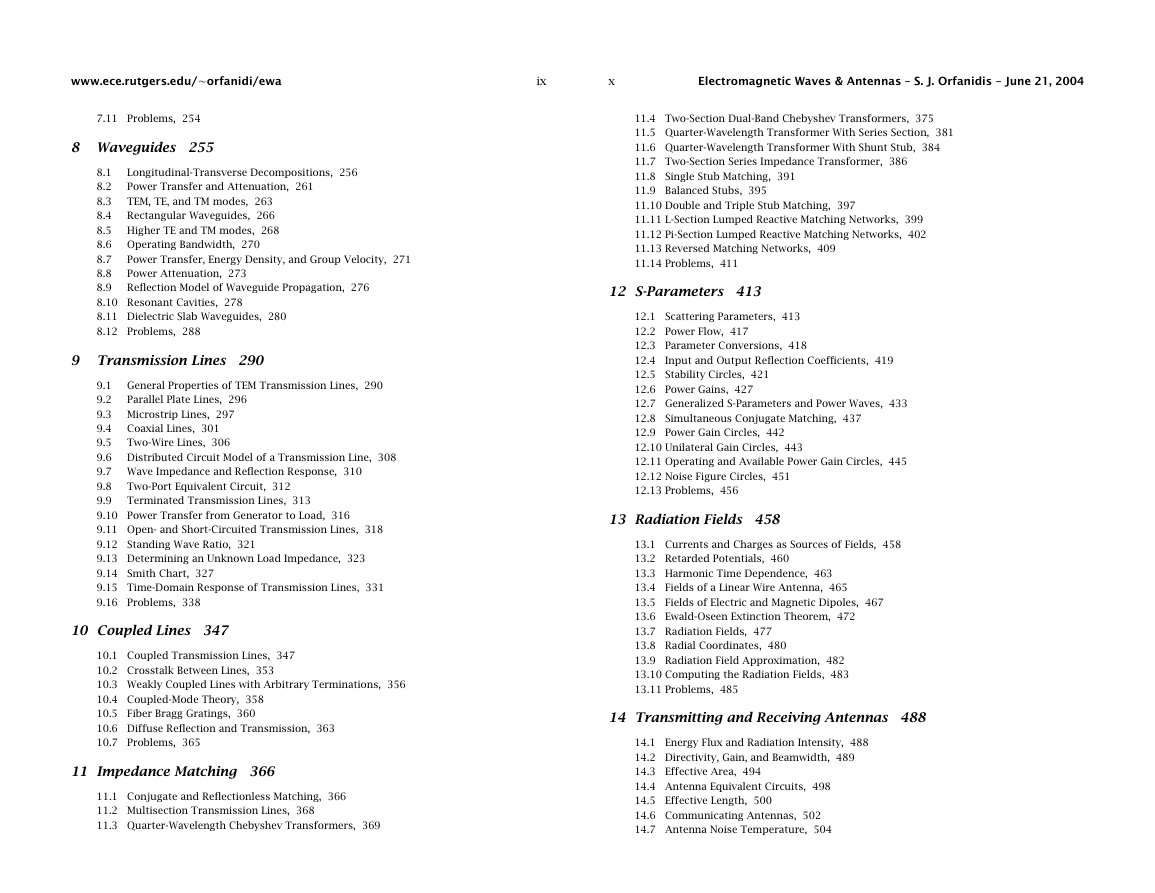
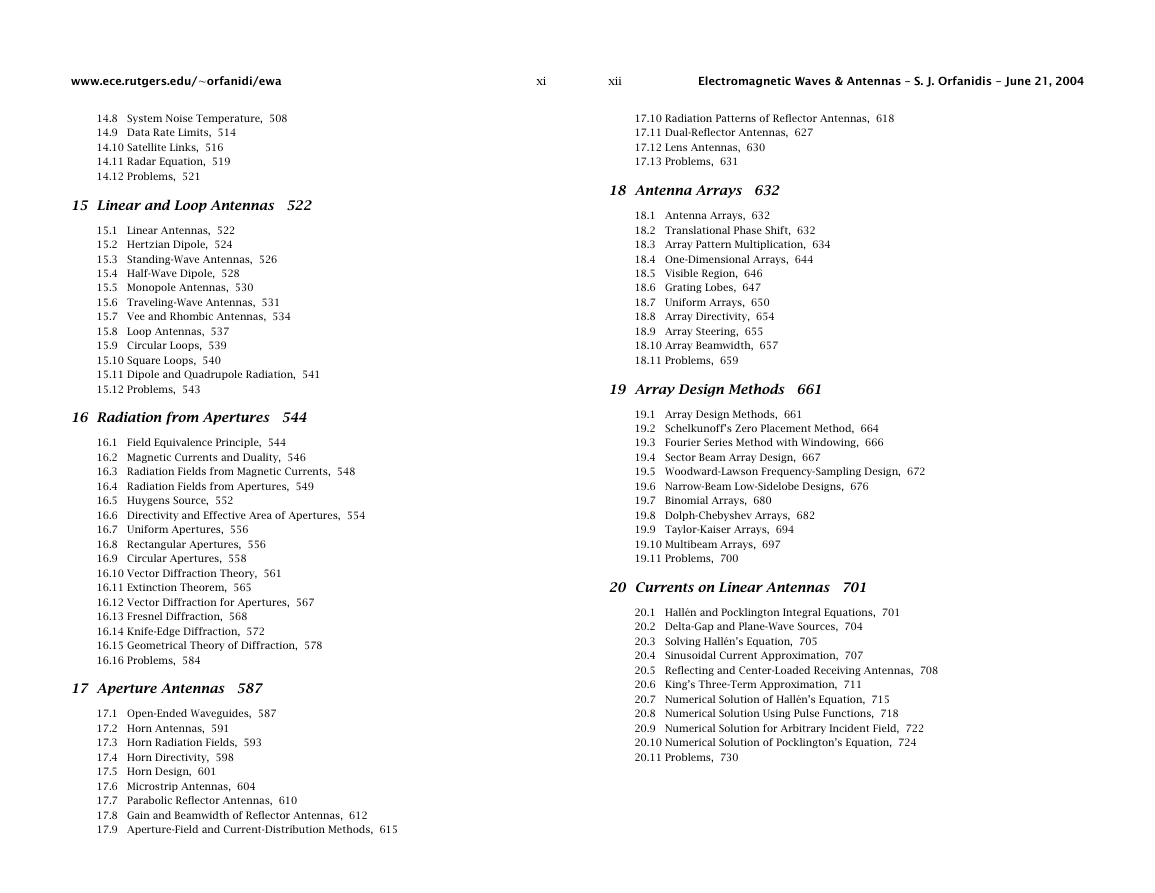
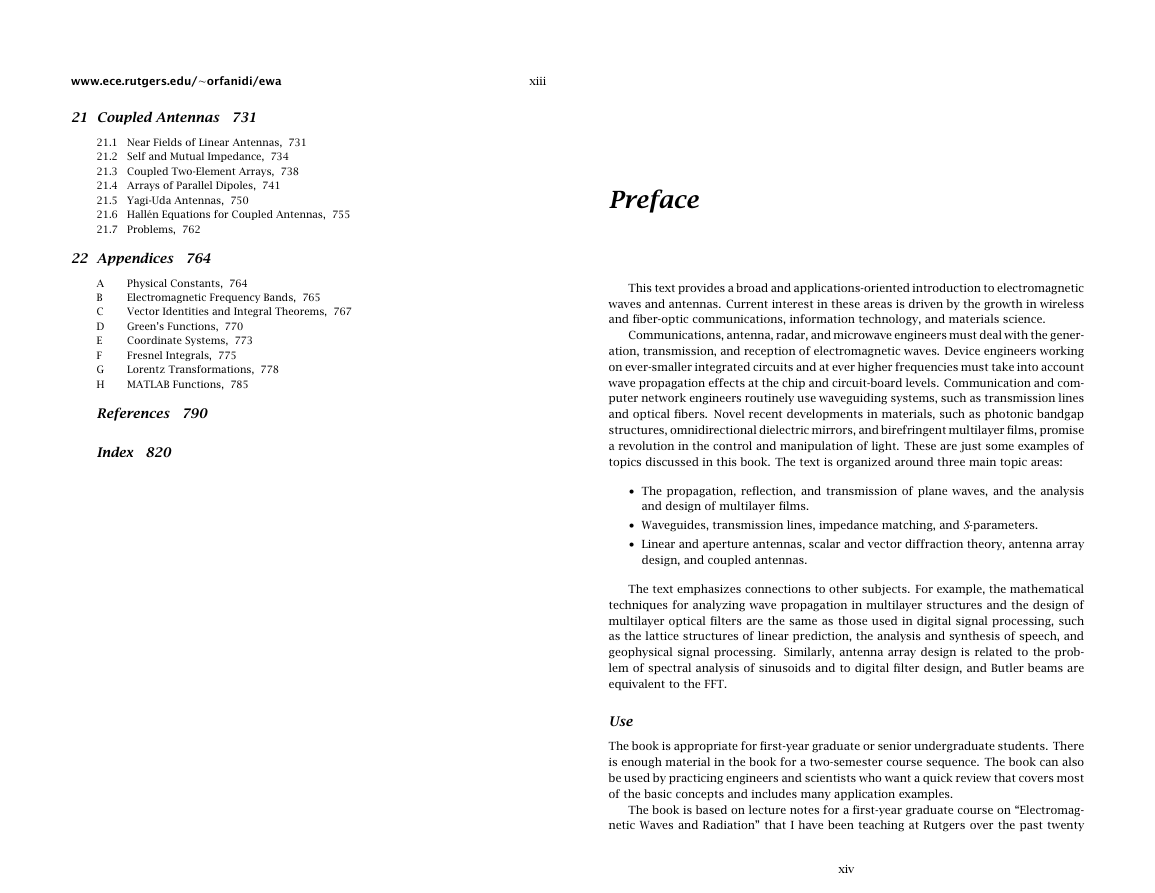
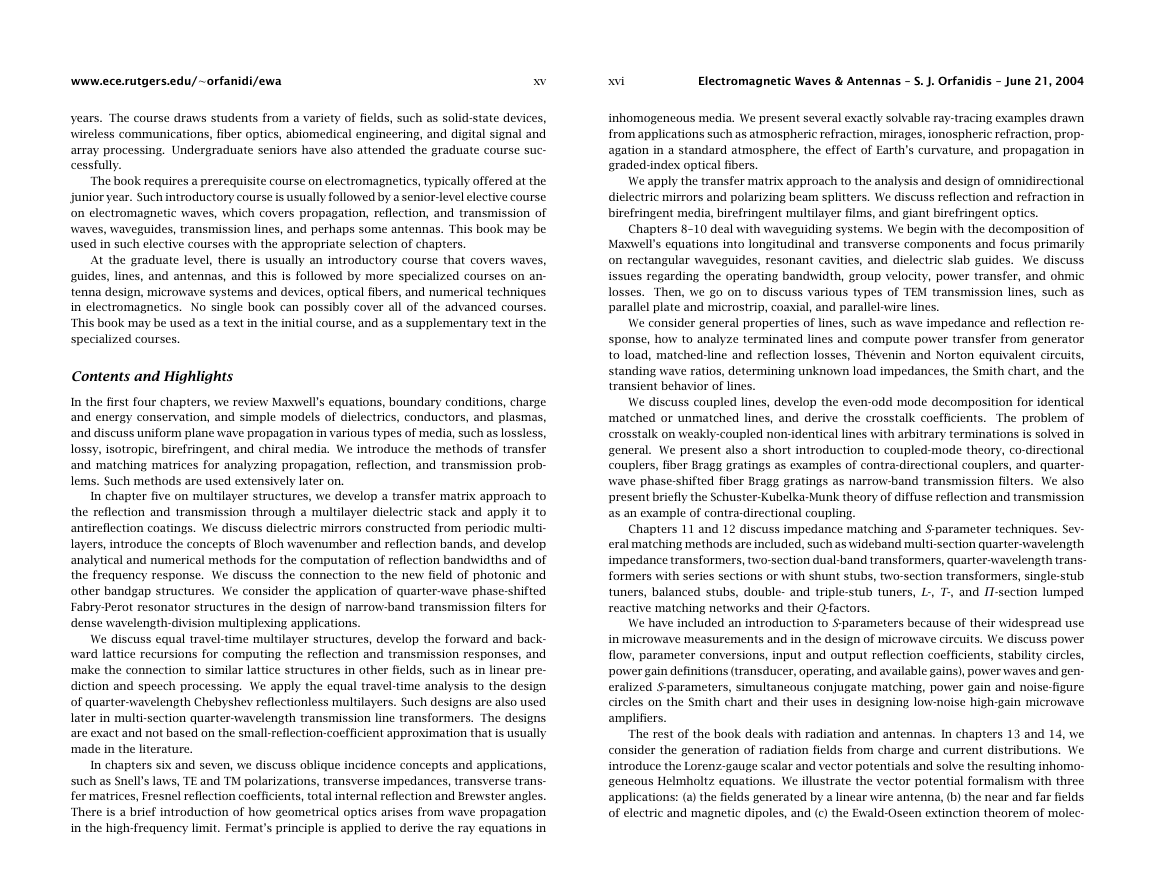
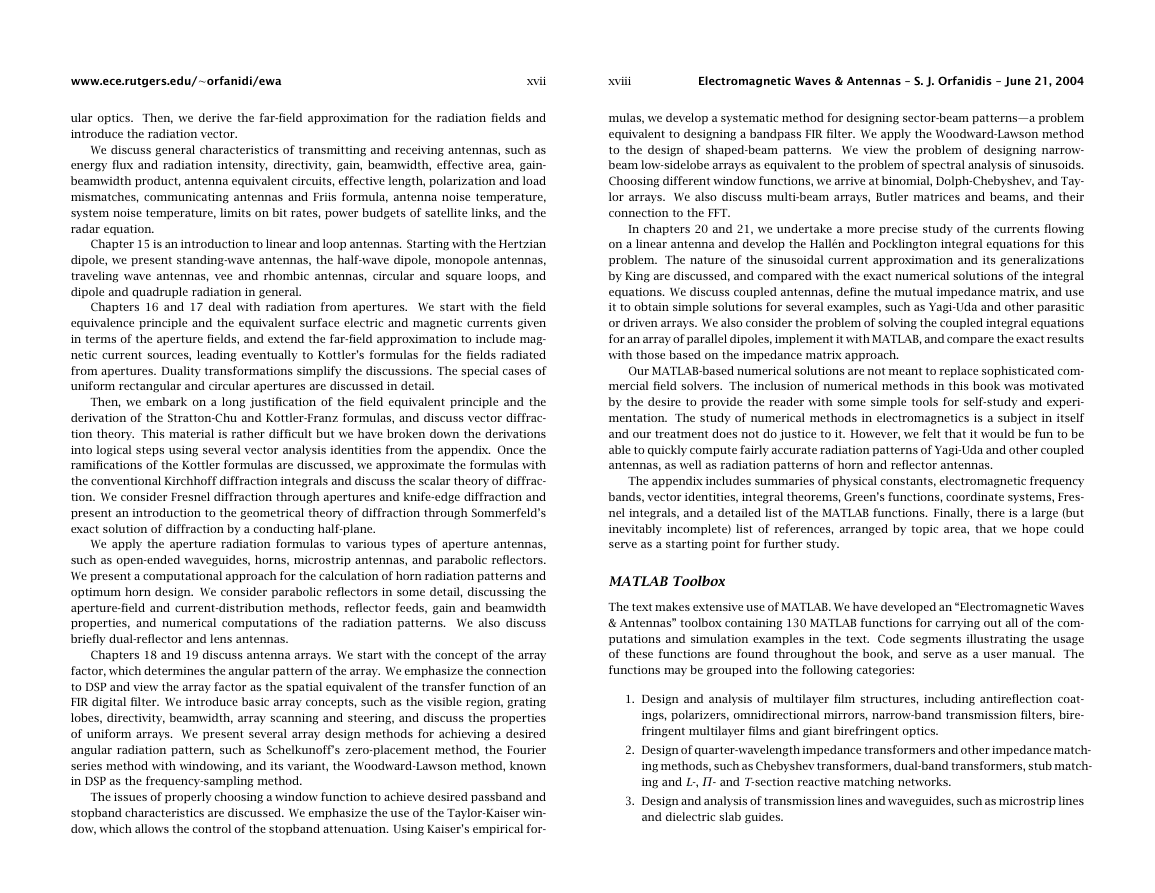








 2023年江西萍乡中考道德与法治真题及答案.doc
2023年江西萍乡中考道德与法治真题及答案.doc 2012年重庆南川中考生物真题及答案.doc
2012年重庆南川中考生物真题及答案.doc 2013年江西师范大学地理学综合及文艺理论基础考研真题.doc
2013年江西师范大学地理学综合及文艺理论基础考研真题.doc 2020年四川甘孜小升初语文真题及答案I卷.doc
2020年四川甘孜小升初语文真题及答案I卷.doc 2020年注册岩土工程师专业基础考试真题及答案.doc
2020年注册岩土工程师专业基础考试真题及答案.doc 2023-2024学年福建省厦门市九年级上学期数学月考试题及答案.doc
2023-2024学年福建省厦门市九年级上学期数学月考试题及答案.doc 2021-2022学年辽宁省沈阳市大东区九年级上学期语文期末试题及答案.doc
2021-2022学年辽宁省沈阳市大东区九年级上学期语文期末试题及答案.doc 2022-2023学年北京东城区初三第一学期物理期末试卷及答案.doc
2022-2023学年北京东城区初三第一学期物理期末试卷及答案.doc 2018上半年江西教师资格初中地理学科知识与教学能力真题及答案.doc
2018上半年江西教师资格初中地理学科知识与教学能力真题及答案.doc 2012年河北国家公务员申论考试真题及答案-省级.doc
2012年河北国家公务员申论考试真题及答案-省级.doc 2020-2021学年江苏省扬州市江都区邵樊片九年级上学期数学第一次质量检测试题及答案.doc
2020-2021学年江苏省扬州市江都区邵樊片九年级上学期数学第一次质量检测试题及答案.doc 2022下半年黑龙江教师资格证中学综合素质真题及答案.doc
2022下半年黑龙江教师资格证中学综合素质真题及答案.doc